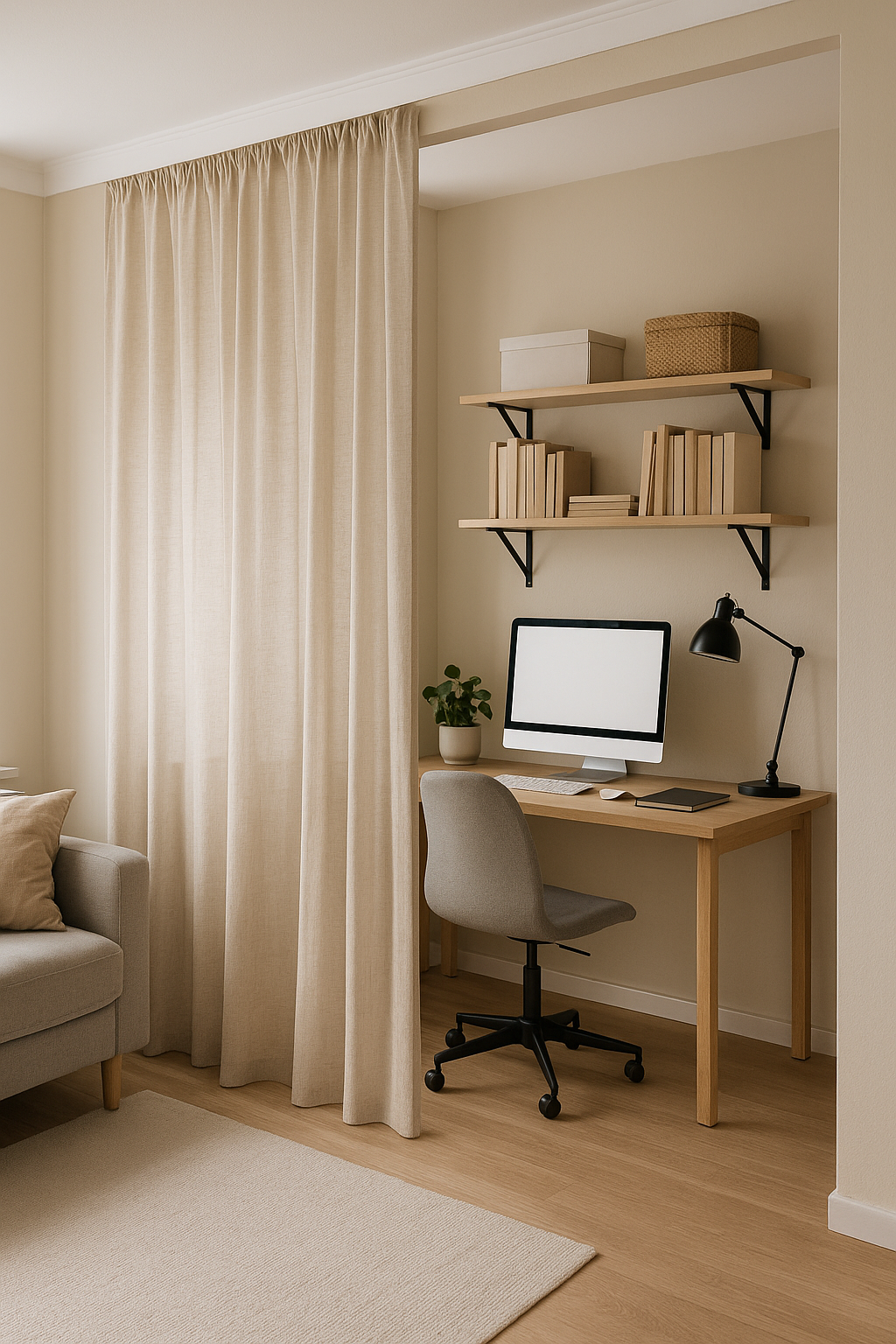As more people work remotely, finding ways to separate your home office from the rest of your living space has become essential—especially in small apartments. However, not everyone has the luxury of a dedicated room, nor the ability to install permanent walls or heavy dividers. That’s where light dividers come in.
Whether you live in a studio or a compact one-bedroom, this article will show you how to create beautiful, functional, and non-invasive dividers that provide visual boundaries, improve focus, and enhance your home’s aesthetics—without overwhelming your space.
Why Use Light Dividers?
A “light” divider refers to a non-permanent, visually lightweight method for dividing space. These dividers:
- Help define your work zone
- Add privacy without blocking natural light
- Keep spaces open and breathable
- Are renter-friendly and easy to move
They create the feeling of a separate room without building walls.
1. Folding Screens and Room Dividers
Best for: Instant separation and flexible layouts
Folding screens are one of the easiest ways to visually block off your workspace.
Types to consider:
- Woven rattan or bamboo (natural, airy)
- Fabric panels (soft and cozy)
- Metal frames with mesh or translucent acrylic (modern and minimal)
Pros:
- Portable and lightweight
- Available in multiple styles
- No installation required
Style tip: Choose a folding screen that complements your room’s color palette for a cohesive look.
2. Curtains or Hanging Drapes
Best for: Flexible and elegant visual separation
Curtains are a soft, stylish way to divide areas without adding visual bulk.
Where to hang them:
- Ceiling-mounted curtain tracks
- Tension rods between two walls
- Hooks and wire systems for renter-friendly options
Fabric ideas:
- Sheer for light and airiness
- Blackout for more privacy or focus
- Linen or cotton for texture and neutrality
Pro tip: Use double-sided curtains for clean views from both sides.
3. Open Bookshelves as Partition Walls
Best for: Combining storage and division
A tall, open bookshelf can function as both a storage unit and a visual boundary.
Benefits:
- Dual-purpose: storage + separation
- Lets light through (if backless)
- Easy to style with plants, books, and baskets
Best placement: Between your desk and bed or sofa to define zones.
Tip: Choose a shelf with uniform compartments for a clean look or go asymmetrical for a playful touch.
4. Sliding Panels or Shoji Screens
Best for: Japanese-inspired minimalism
Shoji screens are made with wood and paper or fabric panels, providing a light, elegant way to divide space.
Advantages:
- Visually calm and clean
- Allow natural light diffusion
- Foldable and often portable
Modern variation: Sliding fabric panels on a ceiling rail can mimic this effect with a contemporary twist.
5. Pegboard or Grid Panel Wall
Best for: DIY enthusiasts and added functionality
Install a vertical pegboard or wire grid panel that functions both as a divider and an organizer.
Use it to:
- Hang office supplies
- Clip inspirational photos
- Mount shelves or baskets
Material options:
- Plywood with painted finish
- Black or white metal grid panels
- IKEA SKÅDIS system
This is especially useful for creative professionals who want a display + divider in one.
6. Tall Indoor Plants or Plant Stands
Best for: Nature lovers and soft separation
Plants provide organic separation while boosting your home’s aesthetic and air quality.
Great choices include:
- Fiddle leaf fig
- Areca palm
- Snake plant (for low light)
- Monstera
- Rubber plant
How to arrange:
- Use tall planters or stands for height
- Line 2–3 plants side by side for a lush effect
- Combine with a plant shelf or hanging vines for more depth
7. Decorative Panels or Macramé Hangers
Best for: Boho and creative interiors
Hang lightweight decorative panels made of:
- Macramé
- Beaded curtains
- Woven fabric art
- Laser-cut wooden screens
They add character while loosely defining your workspace.
Best for: Bedroom nooks, creative studios, or shared rooms where you want subtle definition.
8. Glass or Acrylic Panels
Best for: Modern interiors and maintaining light
If you want a more architectural look, acrylic or tempered glass dividers offer privacy while preserving brightness.
Pros:
- Easy to clean
- Visually modern and sleek
- Works well with metal or wood frames
Ideal for those who want something a bit more polished without losing transparency.
9. Portable Partition Walls on Wheels
Best for: Multi-use spaces
Some light dividers come on wheels and can be repositioned as needed. These are perfect for:
- Shared rooms
- Studio apartments
- Home offices that double as guest spaces
Look for lightweight MDF or laminate versions with caster wheels for easy movement.
10. Hanging Shelves or Storage Panels
Best for: Dual-purpose and space-saving
Install suspended shelves or organizers between ceiling and floor using:
- Vertical poles (like a closet tension rod)
- Ceiling-mounted hooks
- Wall-to-wall hanging rods
These can act as:
- Semi-opaque space dividers
- Storage solutions
- Statement pieces
Use open shelving to keep the room feeling airy.
Additional Tips for Light Divider Success
Match your aesthetic
Choose materials and styles that reflect your apartment’s overall design—whether minimal, boho, industrial, or Scandinavian.
Keep it moveable
In small homes, flexibility is key. Use items that are easy to relocate or remove if needed.
Don’t block natural light
Avoid full-block dividers if they’ll obstruct windows or airflow.
Use symmetry or repetition
If placing multiple items (plants, panels, shelves), use symmetry for balance, or repeat shapes to maintain cohesion.
Creating a light divider for your home office isn’t just about adding a wall—it’s about shaping your environment to support productivity, clarity, and well-being. From folding screens to hanging curtains, open bookshelves to tall plants, there are endless ways to separate your workspace without sacrificing openness or style.
Whether you’re looking for a temporary visual boundary or a functional two-in-one solution, these light divider ideas will help you build a workspace that feels defined, yet fluid—ideal for modern living.

